Statistics for Management Decision Assessment - Semester 1 Report
VerifiedAdded on 2019/10/30
|23
|1493
|487
Homework Assignment
AI Summary
This document presents a detailed solution to a statistics assignment focused on management decision-making. The assignment covers various statistical concepts, including stem and leaf plots, histograms, bar charts, and box and whisker plots. It explores probability distributions like Poisson and Normal distributions, calculating probabilities related to rainfall events. The assignment also delves into hypothesis testing using t-tests to analyze financial ratios and determine statistically significant differences between groups, along with the use of confidence intervals and normality probability plots. The analysis includes interpretation of p-values and making conclusions based on the statistical findings, referencing various academic sources. The assignment demonstrates a strong understanding of statistical methods applied to real-world business scenarios.

Statistics For Management Decision
Assessment -2
Student Id
[Pick the date]
Assessment -2
Student Id
[Pick the date]
Paraphrase This Document
Need a fresh take? Get an instant paraphrase of this document with our AI Paraphraser
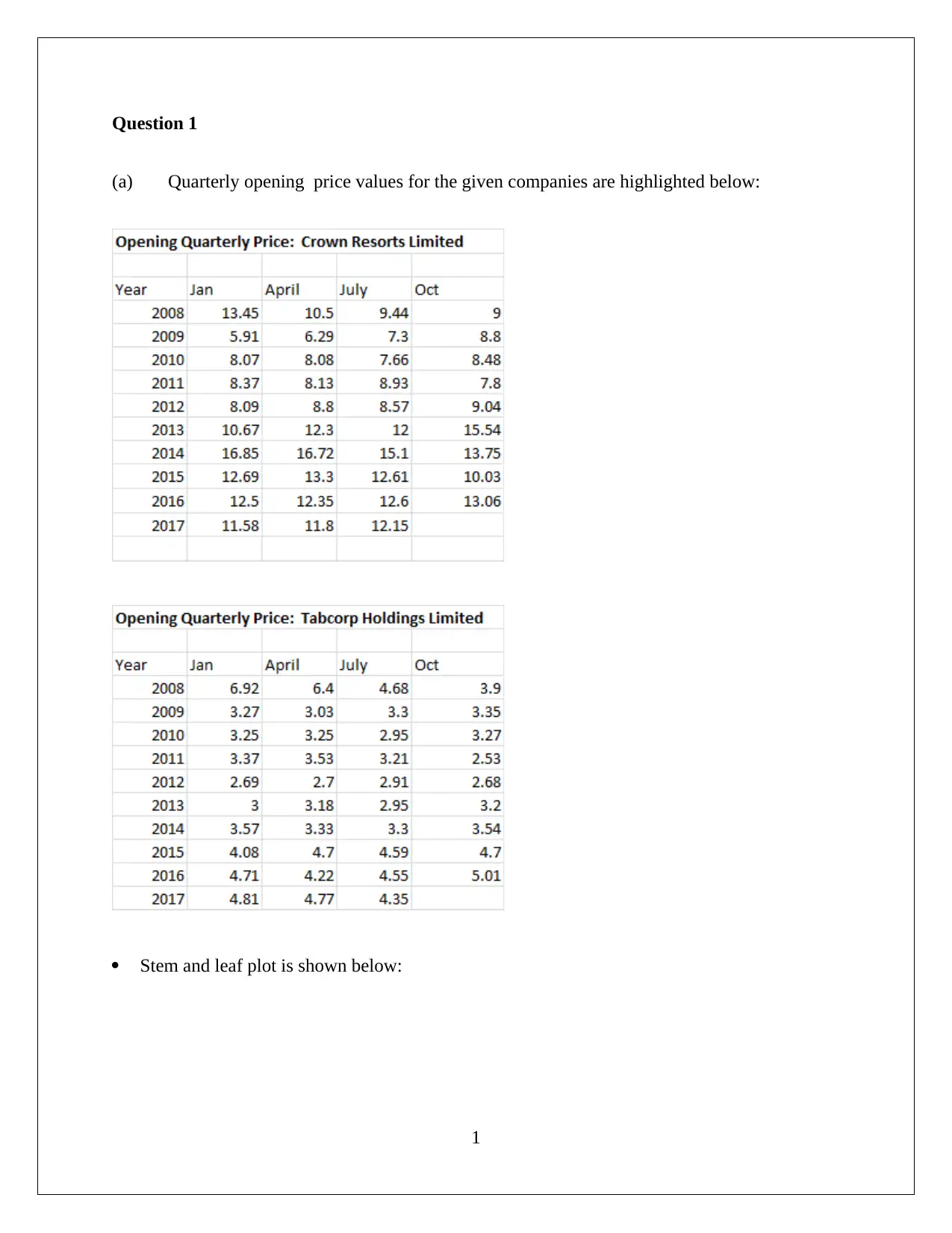
Question 1
(a) Quarterly opening price values for the given companies are highlighted below:
Stem and leaf plot is shown below:
1
(a) Quarterly opening price values for the given companies are highlighted below:
Stem and leaf plot is shown below:
1
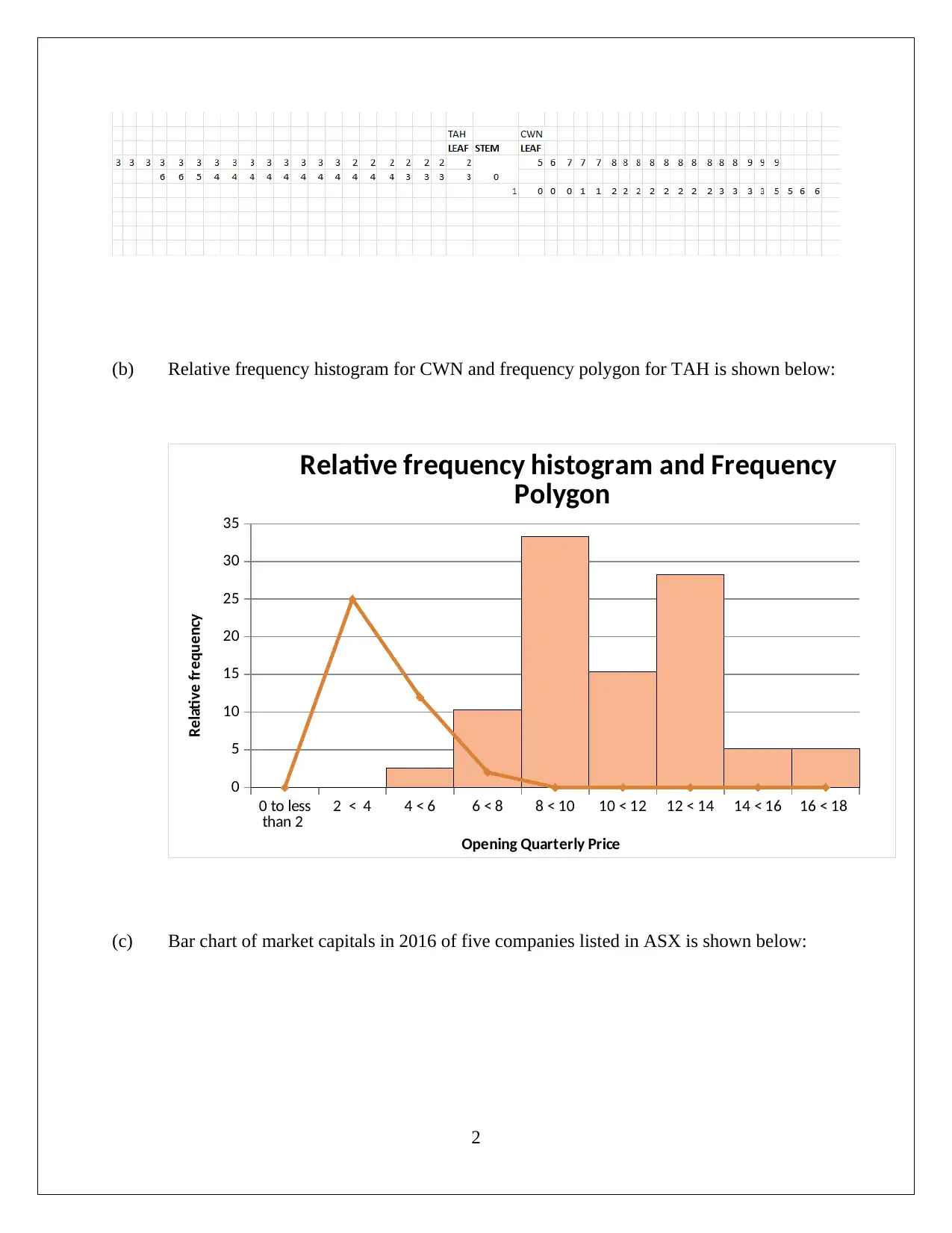
(b) Relative frequency histogram for CWN and frequency polygon for TAH is shown below:
0 to less
than 2 2 < 4 4 < 6 6 < 8 8 < 10 10 < 12 12 < 14 14 < 16 16 < 18
0
5
10
15
20
25
30
35
Relative frequency histogram and Frequency
Polygon
Opening Quarterly Price
Relative frequency
(c) Bar chart of market capitals in 2016 of five companies listed in ASX is shown below:
2
0 to less
than 2 2 < 4 4 < 6 6 < 8 8 < 10 10 < 12 12 < 14 14 < 16 16 < 18
0
5
10
15
20
25
30
35
Relative frequency histogram and Frequency
Polygon
Opening Quarterly Price
Relative frequency
(c) Bar chart of market capitals in 2016 of five companies listed in ASX is shown below:
2
⊘ This is a preview!⊘
Do you want full access?
Subscribe today to unlock all pages.

Trusted by 1+ million students worldwide

Village Roadshow
Tatts Group
Star Entertainment Group
Aristocrat Leisure
Tasracing
0 1 2 3 4 5 6
Bar Chart
Market Capitals (Billion Australian Dollars)
Company NAME
(d) According to Morningstar, there is buy call for CWN while a sell call on TAH based on
the respective fair values which have been computed. For CWN, the estimated fair value
is higher than the current market price while it is the opposite for TAH.
3
Tatts Group
Star Entertainment Group
Aristocrat Leisure
Tasracing
0 1 2 3 4 5 6
Bar Chart
Market Capitals (Billion Australian Dollars)
Company NAME
(d) According to Morningstar, there is buy call for CWN while a sell call on TAH based on
the respective fair values which have been computed. For CWN, the estimated fair value
is higher than the current market price while it is the opposite for TAH.
3
Paraphrase This Document
Need a fresh take? Get an instant paraphrase of this document with our AI Paraphraser
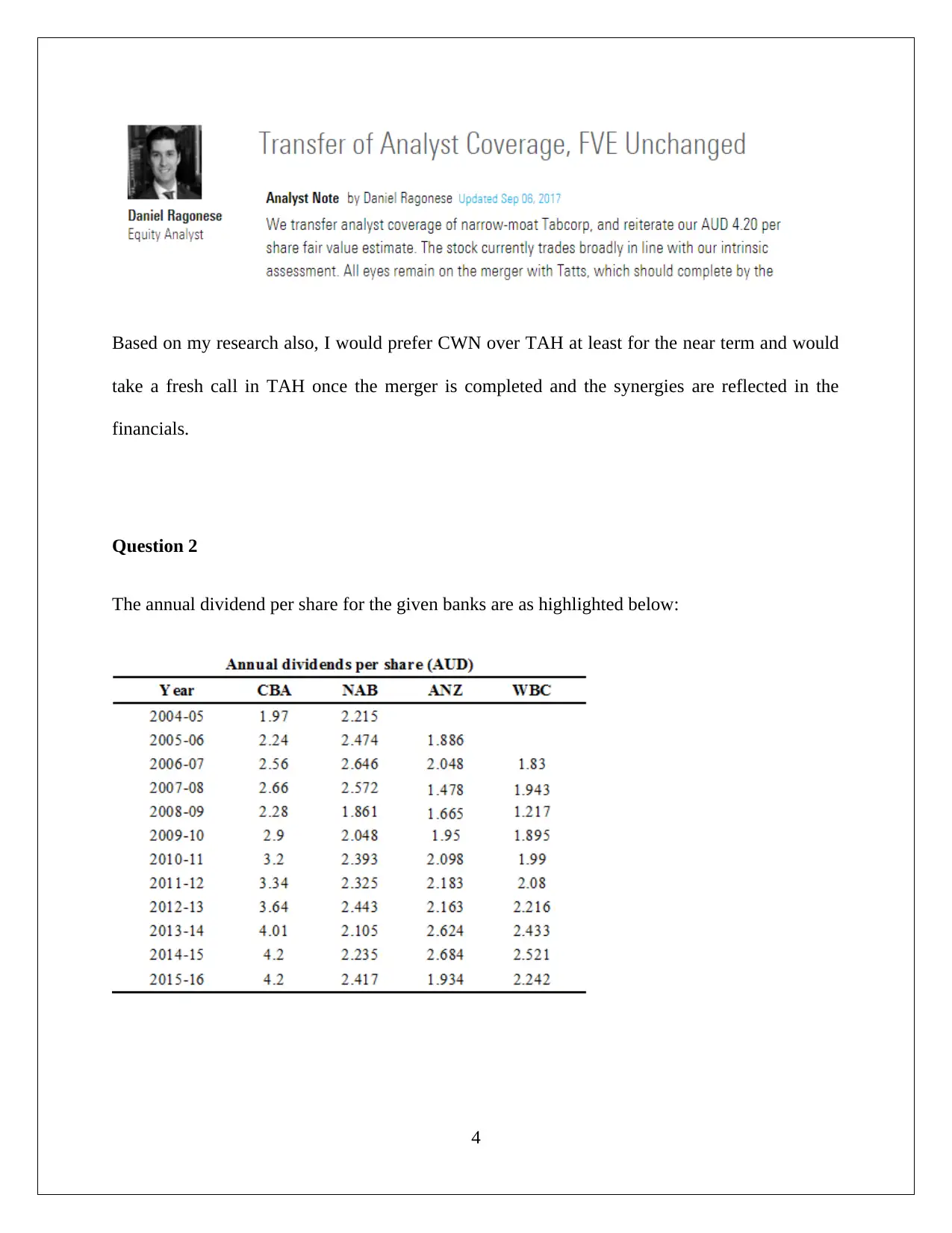
Based on my research also, I would prefer CWN over TAH at least for the near term and would
take a fresh call in TAH once the merger is completed and the synergies are reflected in the
financials.
Question 2
The annual dividend per share for the given banks are as highlighted below:
4
take a fresh call in TAH once the merger is completed and the synergies are reflected in the
financials.
Question 2
The annual dividend per share for the given banks are as highlighted below:
4
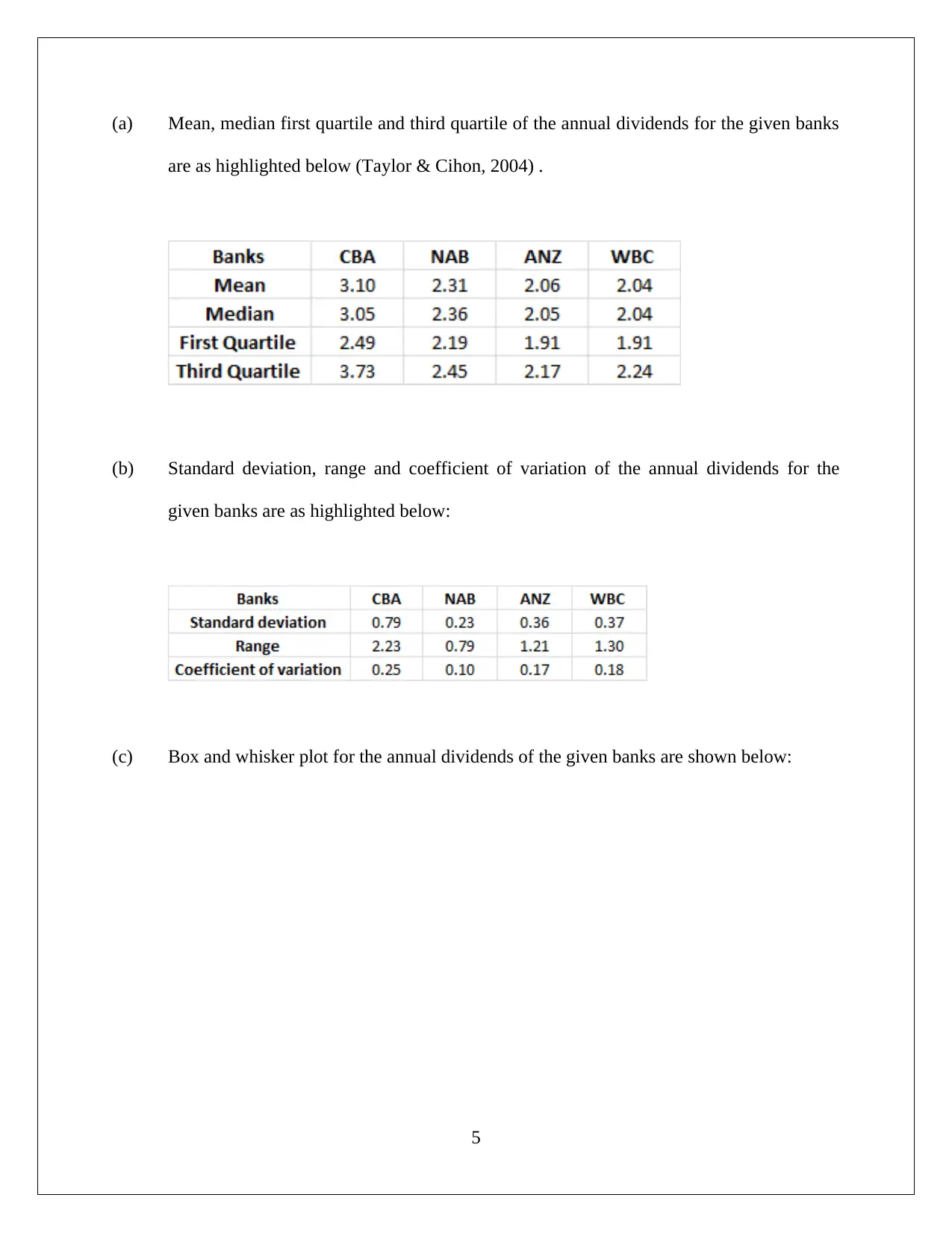
(a) Mean, median first quartile and third quartile of the annual dividends for the given banks
are as highlighted below (Taylor & Cihon, 2004) .
(b) Standard deviation, range and coefficient of variation of the annual dividends for the
given banks are as highlighted below:
(c) Box and whisker plot for the annual dividends of the given banks are shown below:
5
are as highlighted below (Taylor & Cihon, 2004) .
(b) Standard deviation, range and coefficient of variation of the annual dividends for the
given banks are as highlighted below:
(c) Box and whisker plot for the annual dividends of the given banks are shown below:
5
⊘ This is a preview!⊘
Do you want full access?
Subscribe today to unlock all pages.

Trusted by 1+ million students worldwide
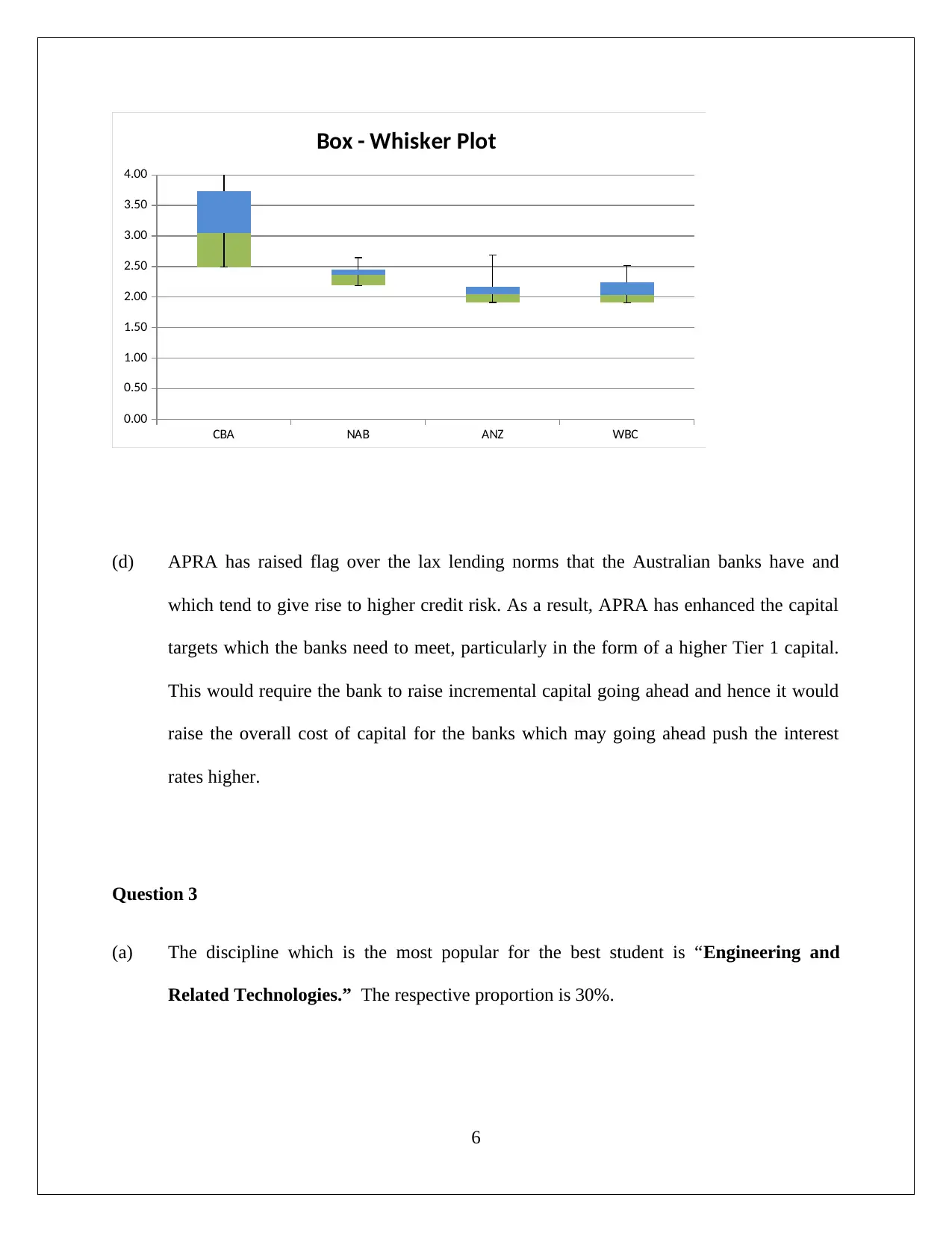
CBA NAB ANZ WBC
0.00
0.50
1.00
1.50
2.00
2.50
3.00
3.50
4.00
Box - Whisker Plot
(d) APRA has raised flag over the lax lending norms that the Australian banks have and
which tend to give rise to higher credit risk. As a result, APRA has enhanced the capital
targets which the banks need to meet, particularly in the form of a higher Tier 1 capital.
This would require the bank to raise incremental capital going ahead and hence it would
raise the overall cost of capital for the banks which may going ahead push the interest
rates higher.
Question 3
(a) The discipline which is the most popular for the best student is “Engineering and
Related Technologies.” The respective proportion is 30%.
6
0.00
0.50
1.00
1.50
2.00
2.50
3.00
3.50
4.00
Box - Whisker Plot
(d) APRA has raised flag over the lax lending norms that the Australian banks have and
which tend to give rise to higher credit risk. As a result, APRA has enhanced the capital
targets which the banks need to meet, particularly in the form of a higher Tier 1 capital.
This would require the bank to raise incremental capital going ahead and hence it would
raise the overall cost of capital for the banks which may going ahead push the interest
rates higher.
Question 3
(a) The discipline which is the most popular for the best student is “Engineering and
Related Technologies.” The respective proportion is 30%.
6
Paraphrase This Document
Need a fresh take? Get an instant paraphrase of this document with our AI Paraphraser

(b) The probability that a randomly selected student would be studying “Society and
Culture” and would have ATAR score of 80 or less is computed below (Taylor & Cihon,
2004).
Probability ¿ 2814+2807+3806 +5030
221060 =0.0654
(c) The discipline which has the highest proportion of students with the lowest ATAR grades
is “Education.” The respective proportion is 7.30%.
(d) The discipline which has majority of the students from “No ATAR/Non-Yr 12”
background is “Health.” The respective proportion is 57.2%. This may be attributed to
the fact that pursuing health courses tend to be expensive and hence some of the high
grade students cannot afford admissions in this course. Also, the admission courses of
these courses is becoming dynamic with increasing emphasis on the various qualities
such as empathy which tend to imperative as a health professional. Hence, there is an
increased focus given to students from non-ATAR backgrounds.
Question 4
(a)
Weekly rainfall event follows “Poisson Distribution”
Total number of weeks = 52
7
Culture” and would have ATAR score of 80 or less is computed below (Taylor & Cihon,
2004).
Probability ¿ 2814+2807+3806 +5030
221060 =0.0654
(c) The discipline which has the highest proportion of students with the lowest ATAR grades
is “Education.” The respective proportion is 7.30%.
(d) The discipline which has majority of the students from “No ATAR/Non-Yr 12”
background is “Health.” The respective proportion is 57.2%. This may be attributed to
the fact that pursuing health courses tend to be expensive and hence some of the high
grade students cannot afford admissions in this course. Also, the admission courses of
these courses is becoming dynamic with increasing emphasis on the various qualities
such as empathy which tend to imperative as a health professional. Hence, there is an
increased focus given to students from non-ATAR backgrounds.
Question 4
(a)
Weekly rainfall event follows “Poisson Distribution”
Total number of weeks = 52
7
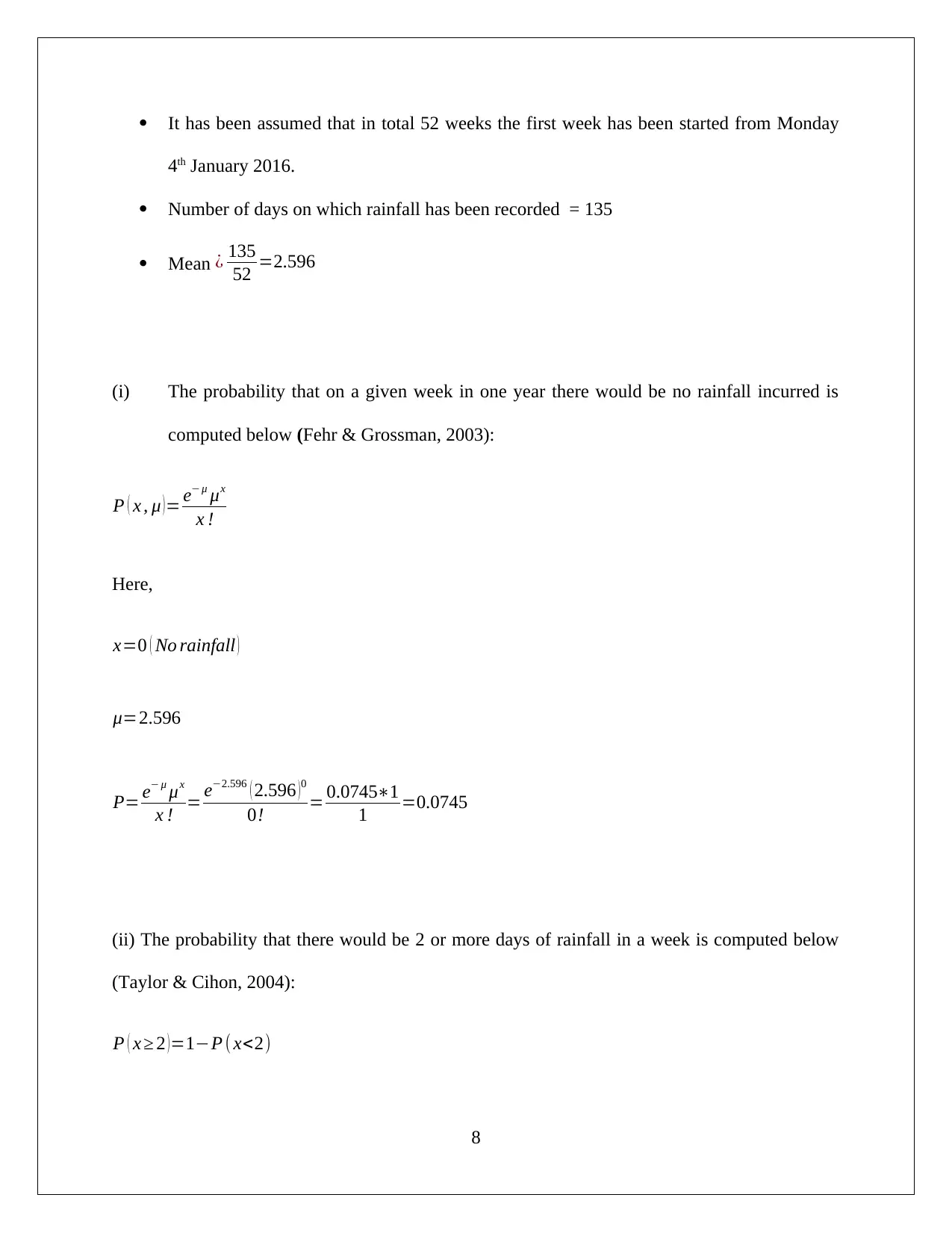
It has been assumed that in total 52 weeks the first week has been started from Monday
4th January 2016.
Number of days on which rainfall has been recorded = 135
Mean ¿ 135
52 =2.596
(i) The probability that on a given week in one year there would be no rainfall incurred is
computed below (Fehr & Grossman, 2003):
P ( x , μ )= e− μ μx
x !
Here,
x=0 ( No rainfall )
μ=2.596
P= e− μ μx
x ! = e−2.596 ( 2.596 )0
0! = 0.0745∗1
1 =0.0745
(ii) The probability that there would be 2 or more days of rainfall in a week is computed below
(Taylor & Cihon, 2004):
P ( x ≥ 2 )=1−P ( x<2)
8
4th January 2016.
Number of days on which rainfall has been recorded = 135
Mean ¿ 135
52 =2.596
(i) The probability that on a given week in one year there would be no rainfall incurred is
computed below (Fehr & Grossman, 2003):
P ( x , μ )= e− μ μx
x !
Here,
x=0 ( No rainfall )
μ=2.596
P= e− μ μx
x ! = e−2.596 ( 2.596 )0
0! = 0.0745∗1
1 =0.0745
(ii) The probability that there would be 2 or more days of rainfall in a week is computed below
(Taylor & Cihon, 2004):
P ( x ≥ 2 )=1−P ( x<2)
8
⊘ This is a preview!⊘
Do you want full access?
Subscribe today to unlock all pages.

Trusted by 1+ million students worldwide
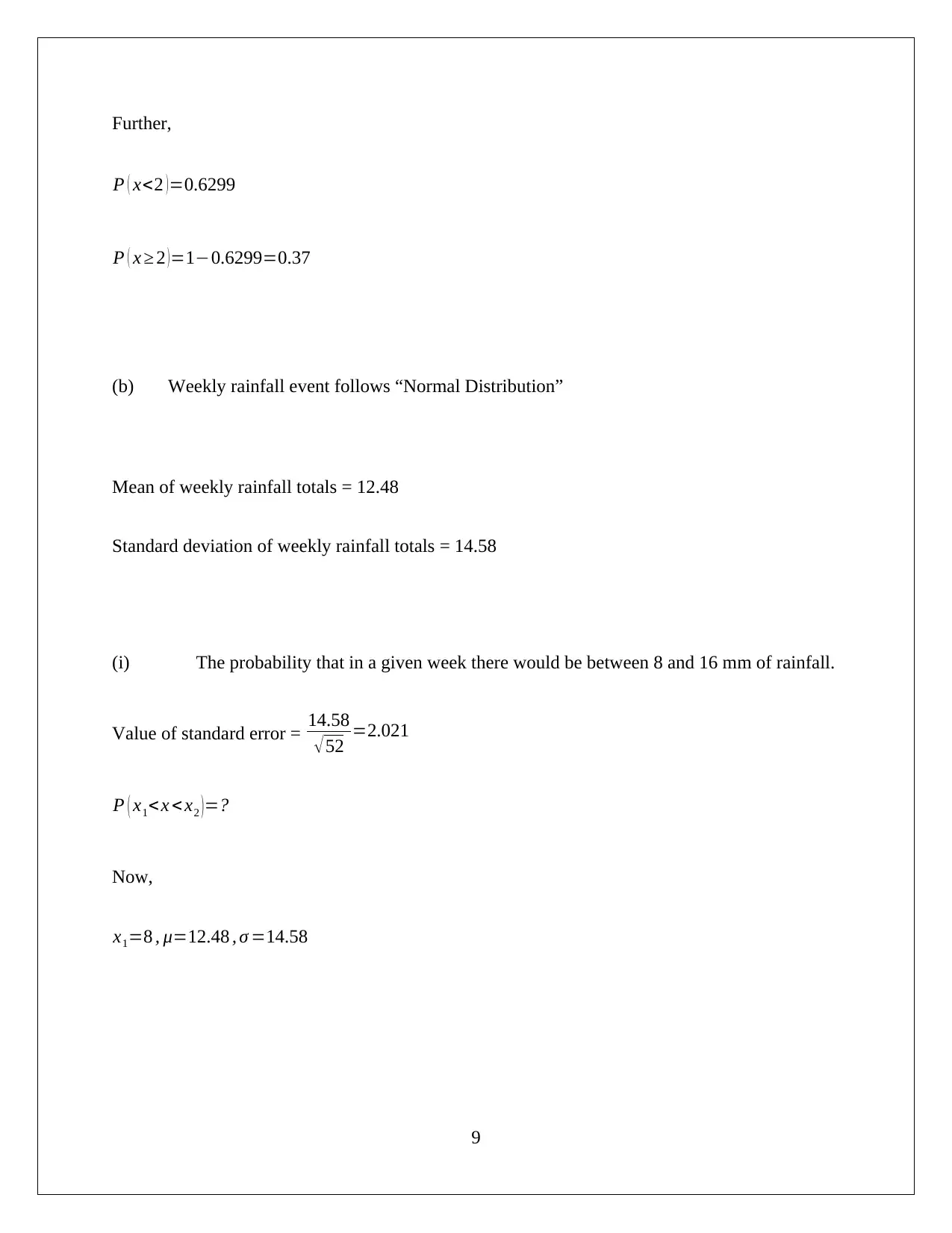
Further,
P ( x<2 )=0.6299
P ( x ≥ 2 ) =1−0.6299=0.37
(b) Weekly rainfall event follows “Normal Distribution”
Mean of weekly rainfall totals = 12.48
Standard deviation of weekly rainfall totals = 14.58
(i) The probability that in a given week there would be between 8 and 16 mm of rainfall.
Value of standard error = 14.58
√52 =2.021
P ( x1<x < x2 )=?
Now,
x1=8 , μ=12.48 , σ =14.58
9
P ( x<2 )=0.6299
P ( x ≥ 2 ) =1−0.6299=0.37
(b) Weekly rainfall event follows “Normal Distribution”
Mean of weekly rainfall totals = 12.48
Standard deviation of weekly rainfall totals = 14.58
(i) The probability that in a given week there would be between 8 and 16 mm of rainfall.
Value of standard error = 14.58
√52 =2.021
P ( x1<x < x2 )=?
Now,
x1=8 , μ=12.48 , σ =14.58
9
Paraphrase This Document
Need a fresh take? Get an instant paraphrase of this document with our AI Paraphraser
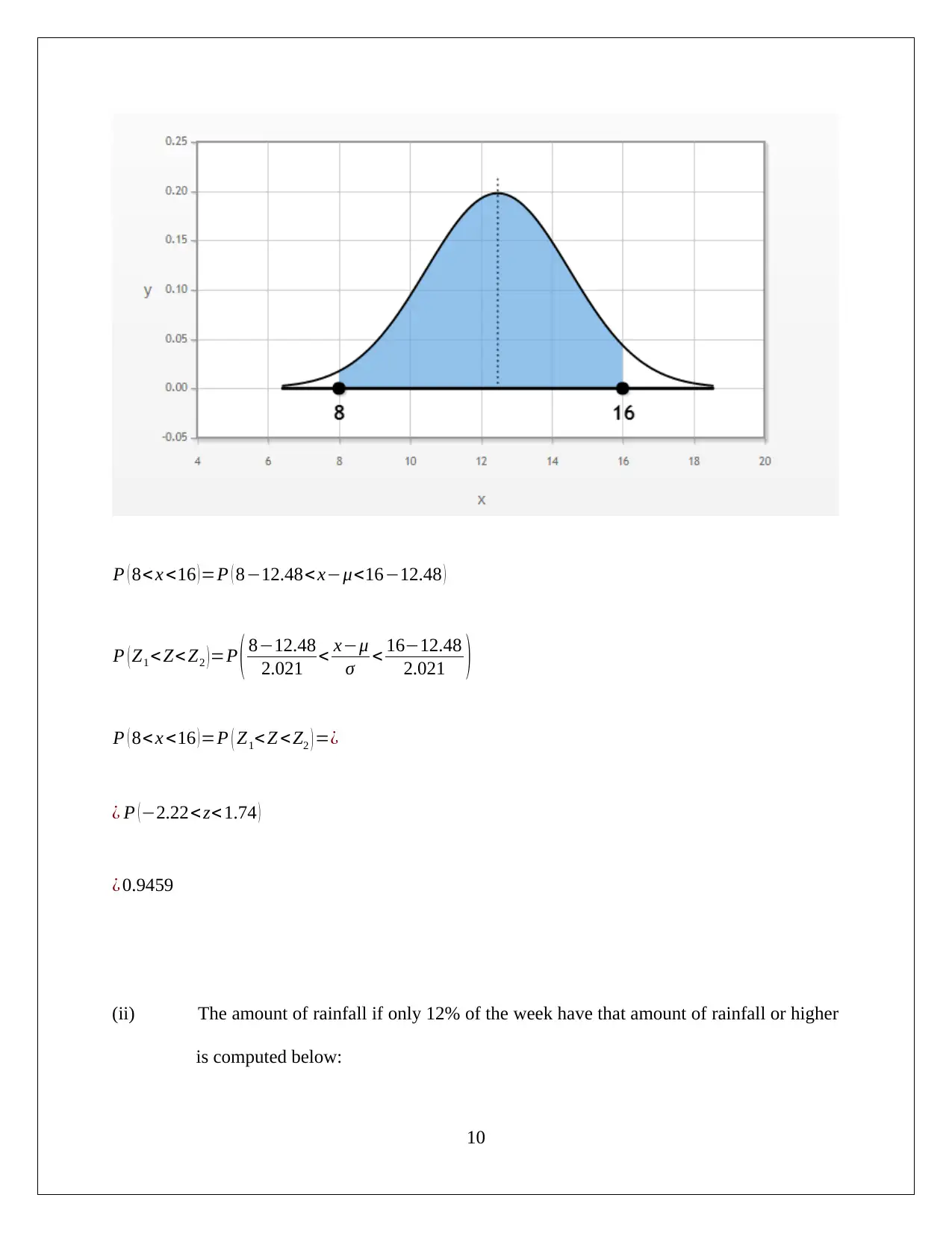
P ( 8< x <16 )=P ( 8−12.48< x−μ<16−12.48 )
P ( Z1 < Z< Z2 )=P ( 8−12.48
2.021 < x−μ
σ < 16−12.48
2.021 )
P ( 8< x <16 ) =P ( Z1< Z <Z2 ) =¿
¿ P ( −2.22< z< 1.74 )
¿ 0.9459
(ii) The amount of rainfall if only 12% of the week have that amount of rainfall or higher
is computed below:
10
P ( Z1 < Z< Z2 )=P ( 8−12.48
2.021 < x−μ
σ < 16−12.48
2.021 )
P ( 8< x <16 ) =P ( Z1< Z <Z2 ) =¿
¿ P ( −2.22< z< 1.74 )
¿ 0.9459
(ii) The amount of rainfall if only 12% of the week have that amount of rainfall or higher
is computed below:
10
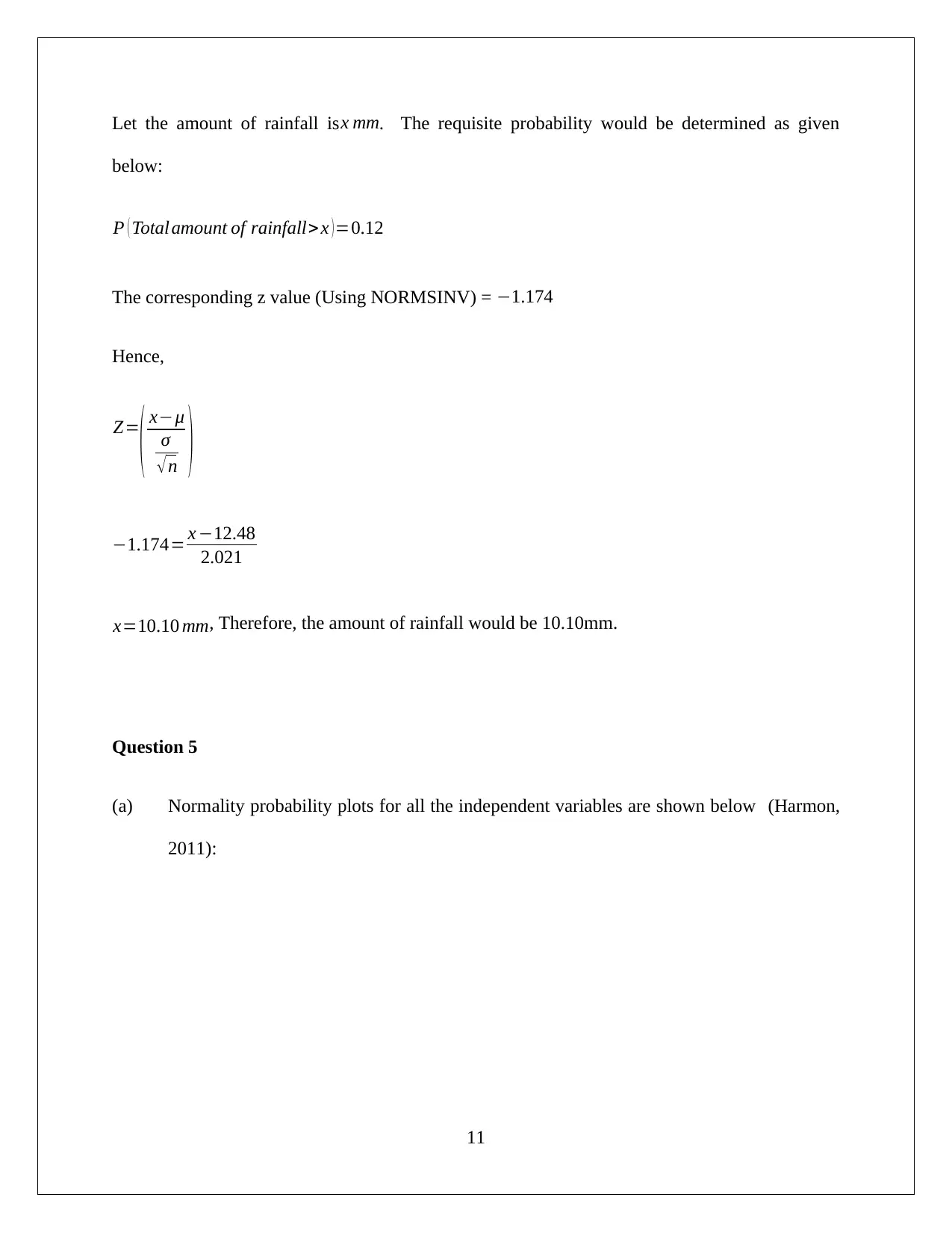
Let the amount of rainfall isx mm. The requisite probability would be determined as given
below:
P ( Totalamount of rainfall>x )=0.12
The corresponding z value (Using NORMSINV) = −1.174
Hence,
Z=
( x−μ
σ
√ n )
−1.174= x −12.48
2.021
x=10.10 mm, Therefore, the amount of rainfall would be 10.10mm.
Question 5
(a) Normality probability plots for all the independent variables are shown below (Harmon,
2011):
11
below:
P ( Totalamount of rainfall>x )=0.12
The corresponding z value (Using NORMSINV) = −1.174
Hence,
Z=
( x−μ
σ
√ n )
−1.174= x −12.48
2.021
x=10.10 mm, Therefore, the amount of rainfall would be 10.10mm.
Question 5
(a) Normality probability plots for all the independent variables are shown below (Harmon,
2011):
11
⊘ This is a preview!⊘
Do you want full access?
Subscribe today to unlock all pages.

Trusted by 1+ million students worldwide
1 out of 23
Related Documents
Your All-in-One AI-Powered Toolkit for Academic Success.
+13062052269
info@desklib.com
Available 24*7 on WhatsApp / Email
![[object Object]](/_next/static/media/star-bottom.7253800d.svg)
Unlock your academic potential
Copyright © 2020–2025 A2Z Services. All Rights Reserved. Developed and managed by ZUCOL.





